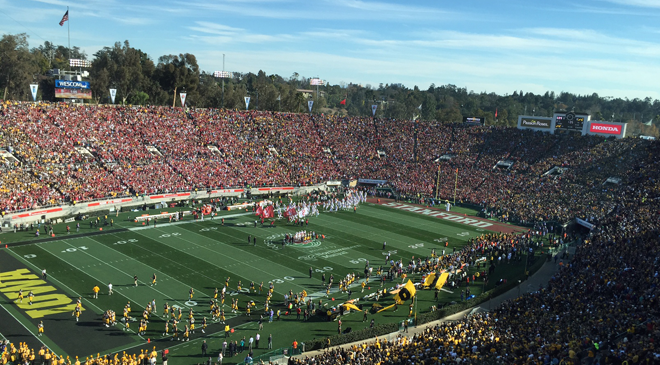The furthest thing from my mind as I strolled the golf course doubling as Rose Bowl Stadium’s parking lot on New Year’s Day 2016 are TV ratings.
I navigate through throngs of Iowa Hawkeye fans. The black-and-gold clad masses, be they acquaintances or total strangers, toasted each other all around the Brookside Golf & Country Club grounds.
“The entire state emptied out!” I heard one Iowa fan shout to another, in response to a “Go Hawks!” called from a nearby tailgate.
Not that the venue this Jan. 1 is merely a western annex of the Hawkeye State, mind you. Despite this being Stanford’s third Rose Bowl Game appearance in four years, the Cardinal faithful are out in force. By kickoff, the split of the 94,000-plus in attendance is nearly 50/50.
Pasadena’s winter air is crisp, but El Nino relented the days prior and won’t exert his wrath on Southern California again until the weekend. The sun’s shining on the kind of picturesque afternoon out-of-towners envision when they think of California. Inside the stadium, the San Gabriel Mountains backdrop couldn’t be any more breathtaking.
And the mystique isn’t exclusive for fans. The players and coaches central to the Rose Bowl Game understand its significance.
That’s especially true for Iowa, a Big Ten charter member that ended a quarter-century long Rose Bowl drought this season.
“It’s an honor. It’s the biggest bowl game there is,” said Iowa quarterback C.J. Beathard at Rose Bowl media day leading up to this year’s installment. “It’s exciting to get out in the stadium and see that atmosphere.”
Iowa head coach Kirk Ferentz joined the Rose Bowl’s alumni as a player in the 1980s, and this season gave him the unique opportunity to experience it from another perspective.
“It’s been 30 years since I’ve been here, and I was here 35 years ago as well,” Ferentz said. “It’s as good as it gets. If you’re a member of the Big Ten, everybody — it’s safe saying everybody — feels that way.”
Everybody fairly applies to the Pac-12, as well, including this year’s representative.
Stanford participated in the first Rose Bowl Game and the 102nd. Its results in the two were very different from a 49-0 loss in 1902, to a 45-16 win in 2016.
The Cardinal have made Pasadena a regular destination under head coach David Shaw, but the magic hasn’t worn off.
“There’s nothing like the Rose Bowl,” Shaw said. “When you pull up to the hotel and you see the roses, you remember as a kid, especially — I watched the Rose Bowl every single year — there is nothing that got in the way of the Rose Bowl: not lunchtime, not other bowl games, not family get-togethers. Our world stopped when the Rose Bowl came around.”
Putting it more succinctly: “It doesn’t get stale,” quarterback Kevin Hogan said.
I’ve covered dozens of college football games, including bowls and other contests at the Rose Bowl that weren’t the Rose Bowl Game. Nothing I experienced before approaches the magic of the Granddaddy. The ghosts of Rose Bowls linger in the California air.
From the Fielding Yost-led Michigan Wolverines, who trekked across the country to face Stanford at Tournament Park on New Year’s Day 1902, to the teams full of men who fought in World Wars, the history of the Rose Bowl Game is a key ingredient of its magic.
Growing up with it a central part of New Year’s, starting with the Tournament of Roses Parade and giving way to the 2 p.m. PT kickoff, finding myself there as an active participant invoked childhood memories. Comparing the genuine article to how I envisioned the Rose Bowl as a youngster, there’s no comparison. Reality far exceeds fantasy in this case.
Admittedly, part of the Rose Bowl’s mystique is rooted in tradition. Tradition is an unavoidable loss in the name of progress, and an improved national championship system was progress college football needed. Too many times in the BCS era, controversy overshadowed the season’s end: a split championship in 2003, Auburn’s exclusion in 2004, Utah and USC each having valid claim to a title shot in 2008, the SEC debacle of 2011.
The Playoff hasn’t eliminated controversy completed. The scandal cast over the sport at the conclusion of the second season in this new era hasn’t a thing to do with on-field results, but rather what people are doing from the comfort of their couches.
Dwindling TV ratings due to this year’s failed New Year’s Eve experiment, compounded by a dip in viewership for the national championship, generated an uproar. The semifinals fell from over 15 points last season, to just below 10 this year. Residual decline cost the title game anywhere from 15-to-23 percent of its total viewing audience compared to 2015.
Money is sport’s Higher Power, and the projected $20 million in lost revenue from the Playoff’s declining audience have sent opinion-makers scurrying to placate their angry god. Among the targets is the Rose Bowl Game’s historic stake to the afternoon of Jan. 1, the latest and grandest piece of college football history potentially put on the chopping block for the sake of a three-game series.
College football’s undergone seismic shifts in the past half-decade, all motivated by the Playoff. Revenue fueled conference realignment, and at the heart of that revenue are the billions the Playoff-powered TV contracts generated.
Conference realignment came with a price. Sacrificed for the pursuit of a “true champion,” and more attention paid by casual fans, are some of the traditions on which college football’s soul is founded. Super-conferences have made some league partners more like distant relatives, who only see each other every few years.
Traditional rivalries died, from the Backyard Brawl to the Border War. Even the complexion of a national holiday changed forever, as Texas A&M left the instability of the Big 12 for the greener pastures of the SEC. With the Aggies’ exit, the Thanksgiving tradition of A&M facing Texas went with it.
Some of these changes were avoidable. Had the Big 12 not acquiesced to Texas’ demands for an exclusive Tier 3 deal, vis a vis the Longhorn Network, A&M might still be in the fold. Perhaps Missouri wouldn’t have left, either. A Big 12 Conference with 12 members wouldn’t now need to contort rules to play a superfluous (albeit lucrative!) championship game.
Likewise, unnecessary changes to college football’s New Year’s tradition are avoidable. The Rose Bowl doesn’t need to move from its traditional, Jan. 1 spot. The first Saturday in January could be a solution, which gives the winners nine days between semifinal and championship. The threat of going head-to-head with the NFL in certain seasons looms then, and this year, the Playoff squandered an uncontested Saturday. But, live and learn.
Should Jan. 1 be the one and only option, there’s no reason the Playoff and Rose Bowl, in seasons the two aren’t one-in-the-same, can’t co-exist. A matinee semifinal preceding the Granddaddy, followed by another semifinal in prime-time, combines the best facets of college football’s history with the strength of its new era.
The Sugar Bowl stakes a claim to New Year’s similar to that of the Rose Bowl, but the Sugar’s case is anything but comparable. Yes, the Sugar Bowl played on New Year’s Day exclusively from its inception in 1935 until 1972, with the lone exceptions coming in years when Jan. 1 fell on a Sunday. In the first half of the 1970s, however, the Sugar Bowl played on New Year’s Eve. It did so again in 1995.
In the 10 years before the College Football Playoff, eight of 10 Sugar Bowls were played on a day in January other than the first. Its place on New Year’s was apparently of little issue in the BCS era — the Jan. 1 edict was the result of a partnership formed between the Big 12 and SEC, amid conference realignment and before particulars of college football’s new postseason were set.
The arrangement, brokered during since-retired SEC commissioner Mike Slive’s tenure, was reactionary in nature and has proven to be unnecessary. However, Slive’s successor, Greg Sankey, remains steadfast in his commitment to New Year’s.
“We have an important and meaningful relationship with the Sugar Bowl that our fans care about,” Sankey said in an address to media Sunday, via GridironNow.com. “We have a direction that is set and given that direction, that answer would be ‘no.’ ”
The question to which Sankey says no is the possibility of moving the Sugar Bowl to Dec. 31 or Jan. 2 for the sake of the Playoff and Rose Bowl. Given the Sugar Bowl’s recent history with Jan. 1 is tenuous at best, the insistence on remaining there feels like little more than petulance — the Big Ten and Pac-12 can’t have a toy the SEC doesn’t.
But the Rose Bowl Game’s place isn’t about conference superiority. It’s a living embodiment of the game’s history.
This is a game that endured the First World War, with Pres. Woodrow Wilson granting special permission to military teams to play in college squads’ stead. The Rose Bowl persisted on New Year’s Day 1942, just weeks after the attack on Pearl Harbor. It had to move to Durham, North Carolina, due to bans on large, public gatherings along the American West Coast. The venue may have changed, but the day didn’t.
The Rose Bowl’s place on New Year’s Day needn’t be another casualty at the altar of the Playoff. If the Rose Bowl Game can make it through World Wars, TV ratings shouldn’t be what changes one of college football’s last remaining, historical cornerstones.



[…] Don’t Change The Rose Bowl Because of Playoff Ratings […]